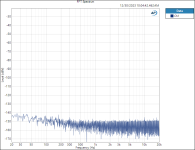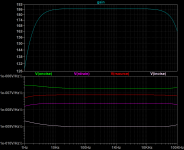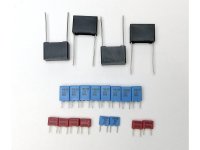The W2893 is .189" dia. and of course Techflex expands, so it seems that this should be good.
Good Morning All,
If there is one thing that bothers me about vinyl playback is power supply ripple in my ear. Make the power line harmonics go away, as in can’t see them on the FFT and can’t hear them in my ear I have a smile on my face. Hiss is a somewhat lesser crime.
This morning I was messing around with my Hammond 16 Ga steel “cookie tin” and once again measured the noise performance of the P3 Capacitance multiplier (ZTX 457) and cascode (new batch of ZTX851) with a 1000uf capacitor at the Capacitance multiplier position.
See the FFT plot below:

The power line harmonics are all but gone. 🙂This is a success, time to move on.
A side note:
Recently I have replaced the 4 foot tube garage lights including the humming ballasts with 5K LED tubes. The hum through the floor is gone.🙂
Other things:
Rolling 0p-amps is in the domain of DIYaudio, go ahead have fun.
You can go on over to ASR and measure the performance difference due to rolling op-amps and find very little or no measurable differences. TonyEE spoke of this
Rolling / Measuring op-amps is small fish compared to rolling jfets and drain resistors.
Thanks DT
If there is one thing that bothers me about vinyl playback is power supply ripple in my ear. Make the power line harmonics go away, as in can’t see them on the FFT and can’t hear them in my ear I have a smile on my face. Hiss is a somewhat lesser crime.
This morning I was messing around with my Hammond 16 Ga steel “cookie tin” and once again measured the noise performance of the P3 Capacitance multiplier (ZTX 457) and cascode (new batch of ZTX851) with a 1000uf capacitor at the Capacitance multiplier position.
See the FFT plot below:

The power line harmonics are all but gone. 🙂This is a success, time to move on.
A side note:
Recently I have replaced the 4 foot tube garage lights including the humming ballasts with 5K LED tubes. The hum through the floor is gone.🙂
Other things:
Rolling 0p-amps is in the domain of DIYaudio, go ahead have fun.
You can go on over to ASR and measure the performance difference due to rolling op-amps and find very little or no measurable differences. TonyEE spoke of this
Rolling / Measuring op-amps is small fish compared to rolling jfets and drain resistors.
Thanks DT
Last edited:
Thank you, Jim (and Randy for the build doc)! I will carefully read before asking more questions... 🙂4-pin XLR compatible with Neutrik D-series.
All these are listed in the BOM in Randy's build document.
😎
https://www.diyaudio.com/community/threads/pearl-3-burning-amp-2023.404054/post-7533872
an alternative connector is the aviation connectors you used to be able to get at radio shack. I've seen 'em on Amazon too.
I used them long ago for my Leach. and I think 6L6 has suggested them previously.
I used them long ago for my Leach. and I think 6L6 has suggested them previously.
I originally used those - have a set of 2, 3, 4, and 5 pin connectors. Since I had some really nice machined circular connectors I went crazy and changed over, but the aviation connectors are quite inexpensive and up to the job.
Y'all are overdoing it with the armchairing. The pearl 3 is the chunkiest, thrustiest, crunchiest phono stage I've heard in my system, across different amps, preamps and crossovers. Just build it & crank it.
YES! It's great out of the box (so to speak).Just build it & crank it.
Just build it and enjoy.
Yes. This phonostage may literally be a giant killer.
I’m looking forward to hearing impressions from builders now that the first batch should be arriving on doorsteps over the next few days.
I’m looking forward to hearing impressions from builders now that the first batch should be arriving on doorsteps over the next few days.
I'm trying to decide what subsonic filtering point to use. I already have 35V 1000uF Rubycons in my stash and would need to order other values if I wanted it to be higher than 0.72 Hz. Are there benefits to going higher?
I spent most of the day matching resistors and caps. 🙂
I spent most of the day matching resistors and caps. 🙂
If anything is problematic it isn't the drain resistor, it's the source resistance which is, effectively, in series with the input.Good Morning All,
If there is one thing that bothers me about vinyl playback is power supply ripple in my ear. Make the power line harmonics go away, as in can’t see them on the FFT and can’t hear them in my ear I have a smile on my face. Hiss is a somewhat lesser crime.
This morning I was messing around with my Hammond 16 Ga steel “cookie tin” and once again measured the noise performance of the P3 Capacitance multiplier (ZTX 457) and cascode (new batch of ZTX851) with a 1000uf capacitor at the Capacitance multiplier position.
See the FFT plot below:
Rolling / Measuring op-amps is small fish compared to rolling jfets and drain resistors.
Thanks DT
Sam Groner had several informative paragraphs on the noise contribution of gate, drain and source resistors in his Linear Audio article "A Low Noise Laboratory-Grade Amplifier". Essentially, the contribution to total noise of Rd is its thermal noise divided by resistance, the contribution to total noise of Rs is its thermal noise.
Attachments
Hello PEARL 3 - builders,
this phono-pre is for sure a 'giant - killer'. My opinion. 😵
It plays on a really high level. I love my PEARL 1, PEARL 2 and for sure the XONO phonopreamps. I am not willed to give one of these away.
Build the PEARL 3 with patience and try to match a few parts (or better all) from left to right channel. I would recommend this especially for the RIAA-section. I have selected/matched each resistor from left to right channel. Also all active devices...
This is a lot of work, but not necessary.
I tested a few OPAmps. Most of the Texas Instruments - OPAmps worked great
OPA1656 - on a SOIC8 to DIP8-adapter - very clean/ analytic and controlled
OPA2604 - very good
LME49720 - similar as good as the OPA1656 - seems a kind of more 'relaxed' to me
OPA2134 - very good, but not preferred by me
I tested many others LM883, RC4580, JRC2680D,... and there are a few in the queue
Some of the OPAmps seem to have shut down? This could be caused by my slightly higher bias for the OPAmps?
I measure 5,5mA over the resistor R27 with an increased value (from 220 Ohm to) of 470 Ohm. I think I will increase R27 again to anywhere around 680 - 750 Ohm. Or another problem?
Till now, I tested all with a pretty normal THORENS vinylplayer and a MM from Ortofon (VM red).
Today I will try another THORENS with an ORTOFON MC20 SUPER (MC) at the PEARL 3. Should be better...
Enjoy the build and later the sound...
I wish you all a smooth glide into 2024!
Dirk 🙂
this phono-pre is for sure a 'giant - killer'. My opinion. 😵
It plays on a really high level. I love my PEARL 1, PEARL 2 and for sure the XONO phonopreamps. I am not willed to give one of these away.
Build the PEARL 3 with patience and try to match a few parts (or better all) from left to right channel. I would recommend this especially for the RIAA-section. I have selected/matched each resistor from left to right channel. Also all active devices...
This is a lot of work, but not necessary.
I tested a few OPAmps. Most of the Texas Instruments - OPAmps worked great
OPA1656 - on a SOIC8 to DIP8-adapter - very clean/ analytic and controlled
OPA2604 - very good
LME49720 - similar as good as the OPA1656 - seems a kind of more 'relaxed' to me
OPA2134 - very good, but not preferred by me
I tested many others LM883, RC4580, JRC2680D,... and there are a few in the queue
Some of the OPAmps seem to have shut down? This could be caused by my slightly higher bias for the OPAmps?
I measure 5,5mA over the resistor R27 with an increased value (from 220 Ohm to) of 470 Ohm. I think I will increase R27 again to anywhere around 680 - 750 Ohm. Or another problem?
Till now, I tested all with a pretty normal THORENS vinylplayer and a MM from Ortofon (VM red).
Today I will try another THORENS with an ORTOFON MC20 SUPER (MC) at the PEARL 3. Should be better...
Enjoy the build and later the sound...
I wish you all a smooth glide into 2024!
Dirk 🙂
If anything is problematic it isn't the drain resistor, it's the source resistance which is, effectively, in series with the input.
Hello jackinnj,
In terms of hiss I completely agree. I mentioned that 47K resistor in a previous post.
The drain resistor is in regard to rolling the jfets and jefet bias point compared to rolling op-amps.
Rolling the jfets and drain resistors will have a larger effect on distortion, by a large amount, than rolling op-amps.
Thanks DT
Having a hard time inventorying/measuring some of the caps, numerical count seems right but...There are 6 Wima 100/400, 5 0n flip side, I don't see any qty 6 in the BOM. There are also 2 small non-descript that my meter doesn't seem to be able to measure too well.
Last edited:
LME49720 = LM4562LME49720 - similar as good as the OPA1656 - seems a kind of more 'relaxed' to me
The 47k input resistor is shunted by a low impedance -- the cartridge.The Device Under Test is not only the Regulator. The regulator is not the only offender. The raw DC power supply looks to be a worse offender. The jfets and 47K input resistor contribute additional noise.
- Home
- Amplifiers
- Pass Labs
- Pearl 3 Burning Amp 2023





